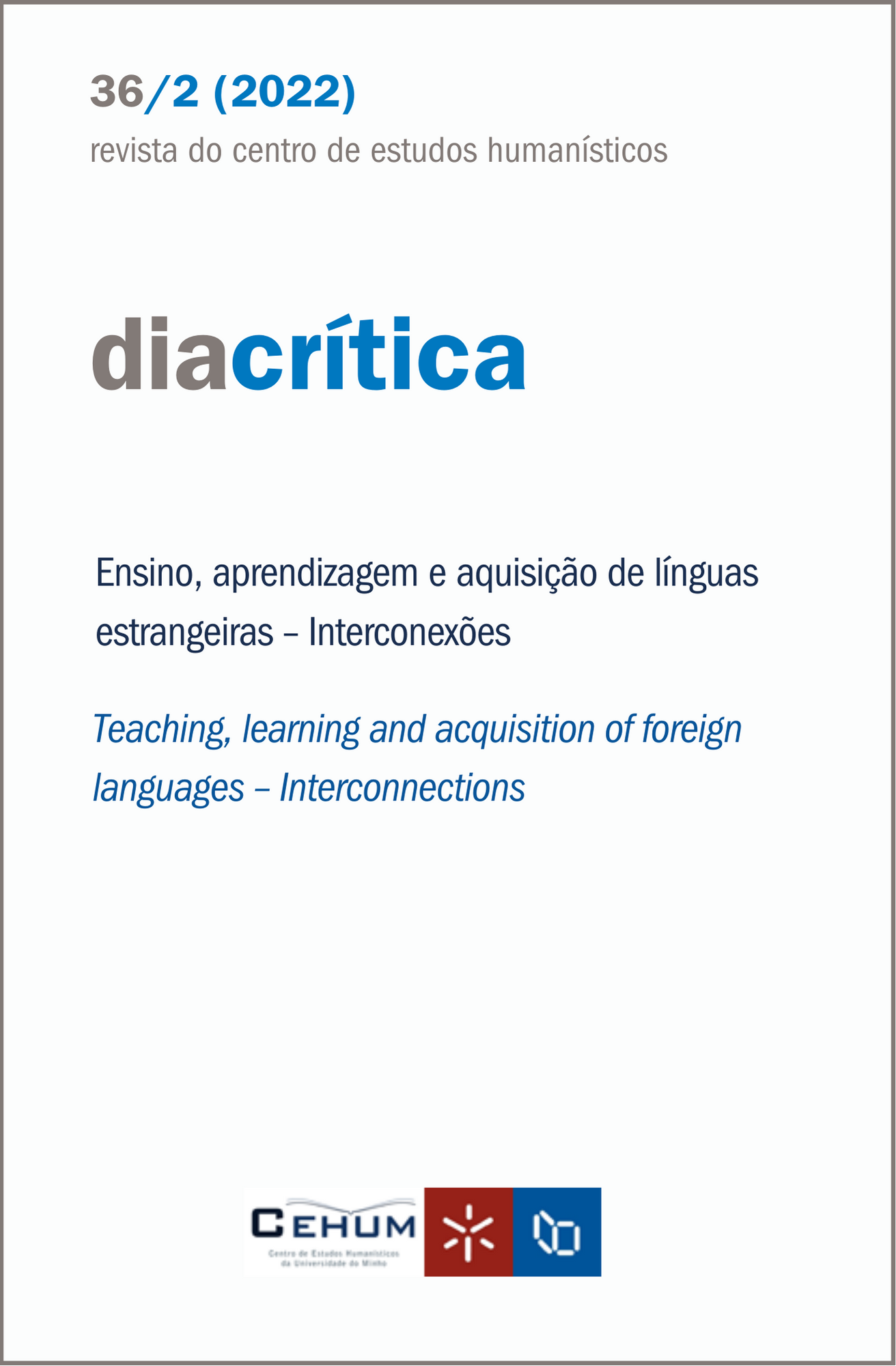The difficult acquisition of the subjunctive vs indicative moods by Portuguese and Francophone learners
DOI:
https://doi.org/10.21814/diacritica.4809Keywords:
Subjunctive, Indicative, Foreign Language, Mother Tongue, French, PortugueseAbstract
Grammar acquisition in a foreign language has always proven to be a difficult task, taking into account the prominence given, at times, to communicative competence to the detriment of the language accuracy. The subjunctive is a relevant example of this issue, insofar as its assimilation and use is always a lengthy and arduous process. Since Portuguese and French are two relatively close Romance languages, students would be expected to use the subjunctive mood appropriately, as it occurs in similar contexts in both languages. However, the analysis of students' discourse has revealed difficulties in selecting the appropriate mood, the subjunctive vs the indicative, even when both their mother tongues and the foreign language would employ the same verbal mood. Therefore, the aim of this paper is to determine whether the problematic choice of the appropriate mood occurs in the same contexts in both languages or whether the difficulties manifested by each group of learners are inherent to the values that the subjunctive exhibits in their mother tongue, despite the similarities between French and Portuguese.
References
Abranches, C. (2009, janeiro). L’emploi du subjonctif dans les subordonnées compléments d’objet après volitifs [Comunicação]. XVI Congrès de l’Association Portugaise des Professeurs de Français (APPF), Lisboa (inédita).
Blanche-Benveniste, C., & Valli, A. (1997). L’expérience EuRom4 : comment négocier les difficultés?. Le Français dans le Monde – Recherches et Applications, Janvier 1997 numéro spécial, 110–115.
Blanche-Benveniste, C. (2000). De l’intérêt des approches contrastives. Le Français dans le Monde – Recherches et Applications, Janvier 2000 numéro spécial, 95–97.
Cadiot-Cueilleron, J., Fayssinhes, J.-P., Klotz, L., Lefebvre du Preÿ, N., & Motgolfier, J. (1992). Grammaire Cours de Civilisation française de la Sorbonne – 350 exercices, Niveau Supérieur I. Hachette F.L.E.
Charaudeau, P. (1992). Grammaire du sens et de l’expression. Hachette Éducation.
Debyser, F. (1970). La linguistique contrastive et les interférences. Langue française, 8, 31–61. DOI: https://doi.org/10.3406/lfr.1970.5527
Gaatone, D. (2003). La nature plurielle du subjonctif français. In M. Berré, A. Van Slijcke & P. Hadermann (Eds.), La syntaxe raisonnée. Mélanges de linguistique générale et française offerts à Annie Boone à l'occasion de son 60e anniversaire (pp. 57–78). De Boeck Supérieur. DOI: https://doi.org/10.3917/dbu.berre.2003.01.0057
Jamet, C. (2005). Identification de problèmes et contrastivité. Les Sciences de l’éducation – Pour l’ère nouvelle, 38/3, 95–113. https://doi.org/10.3917/lsdle.383.0095 DOI: https://doi.org/10.3917/lsdle.383.0095
Marques, R. (1995). Sobre o valor dos modos conjuntivo e indicativo em português [Dissertação de mestrado, Faculdade de Letras da Universidade de Lisboa]. https://www.clul.ulisboa.pt/files/rui_marques/Sobre_os_valores_dos_modos_conjuntivo_e_indicativo_em_portugus.pdf
Marques, R. (1997). Sobre a seleção de modo em orações completivas. In I. Castro (Ed.), Actas do XII Encontro Nacional da Associação Portuguesa de Linguística (Braga-Guimarães, 30 de setembro a 2 de outubro de 1996 (vol. 1, pp. 191–202). Associação Portuguesa de Linguística.
Marques, R. (2013). O Modo. In E. Buzaglo Paiva Raposo, M. F. Bacelar do Nascimento, M.A. Coelho da Mota, L. Segura & A. Mendes (Eds.), Gramática do Português (vol. 1, pp. 673–693). Fundação Calouste Gulbenkian.
Mendes, A., Antunes, S., Janssen, M., & Anabela Gonçalves. (2016). The COPLE2 Corpus: A learner corpus for Portuguese. In N. Calzolari, K. Choukri, T. Declerck, S. Goggi, M. Grobelnik, B. Maegaard, J. Mariani, H. Mazo, A. Moreno, J. Odijk, & S. Piperidis (Eds.), Proceedings of the Tenth Language Resources and Evaluation Conference – LREC’16, 23-28 May 2016 (3207–3214). European Language Resources Association (ELRA). http://www.lrec-conf.org/proceedings/lrec2016
Rihs, A. (2016). Le subjonctif comme marqueur procédural. Syntaxe et sémantique, 17, 57–73. https://doi.org/10.3917/ss.017.0057 DOI: https://doi.org/10.3917/ss.017.0057
Saint Moulin, G. (2004). Pour une démarche contrastive en classe de langue : application à la voix pronominale. In J. Greenfield (Ed.), Ensino das Línguas Estrangeiras: Estratégias Políticas e Educativas (pp. 51–68). Faculdade de Letras da Universidade do Porto.
Simone, R. (1997). Langues romanes de toute l’Europe, unissez-vous!. Le Français dans le Monde – Recherches et Applications, Janvier 1997 numéro spécial, 25–33.
TLFI – Trésor de la langue Française informatisé. ATILF/CNRS – Université de Lorraine. http://atilf.atilf.fr/tlf.htm
Yllera Fernández, A. (2001). Linguistique contrastive, linguistique comparée ou linguistique tout court?. In I. Uzcanga Vivar, E. Llamas Pombo & J.M. Pérez Velasco (Eds.), Presencia y renovación de la lingüistica francesa (pp. 435–446). Ediciones Universidad de Salamanca.
Downloads
Published
How to Cite
Issue
Section
License
Copyright (c) 2023 Maria Helena Marques Antunes

This work is licensed under a Creative Commons Attribution-NonCommercial 4.0 International License.










